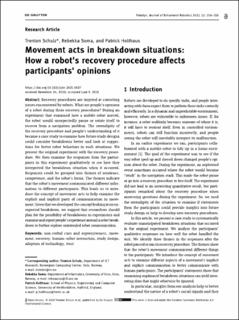| dc.contributor.author | Schulz, Trenton Wade | |
| dc.contributor.author | Soma, Rebekka | |
| dc.contributor.author | Holthaus, Patrick | |
| dc.date.accessioned | 2021-08-25T11:50:22Z | |
| dc.date.available | 2021-08-25T11:50:22Z | |
| dc.date.created | 2021-08-20T15:06:51Z | |
| dc.date.issued | 2021 | |
| dc.identifier.citation | Paladyn - Journal of Behavioral Robotics. 2021, 12 (1), 336-355. | en_US |
| dc.identifier.issn | 2080-9778 | |
| dc.identifier.uri | https://hdl.handle.net/11250/2771180 | |
| dc.description.abstract | Recovery procedures are targeted at correcting issues encountered by robots. What are people’s opinions of a robot during these recovery procedures? During an experiment that examined how a mobile robot moved, the robot would unexpectedly pause or rotate itself to recover from a navigation problem. The serendipity of the recovery procedure and people’s understanding of it became a case study to examine how future study designs could consider breakdowns better and look at suggestions for better robot behaviors in such situations. We present the original experiment with the recovery procedure. We then examine the responses from the participants in this experiment qualitatively to see how they interpreted the breakdown situation when it occurred. Responses could be grouped into themes of sentience, competence, and the robot’s forms. The themes indicate that the robot’s movement communicated different information to different participants. This leads us to introduce the concept of movement acts to help examine the explicit and implicit parts of communication in movement. Given that we developed the concept looking at an unexpected breakdown, we suggest that researchers should plan for the possibility of breakdowns in experiments and examine and report people’s experience around a robot breakdown to further explore unintended robot communication. | |
| dc.language.iso | eng | en_US |
| dc.rights | Navngivelse-Ikkekommersiell-DelPåSammeVilkår 4.0 Internasjonal | * |
| dc.rights.uri | http://creativecommons.org/licenses/by-nc-sa/4.0/deed.no | * |
| dc.title | Movement acts in breakdown situations: How a robot's recovery procedure affects participants' opinions | en_US |
| dc.type | Journal article | en_US |
| dc.type | Peer reviewed | en_US |
| dc.description.version | publishedVersion | |
| cristin.ispublished | true | |
| cristin.fulltext | original | |
| cristin.qualitycode | 1 | |
| dc.identifier.doi | 10.1515/pjbr-2021-0027 | |
| dc.identifier.cristin | 1927733 | |
| dc.source.journal | Paladyn - Journal of Behavioral Robotics | en_US |
| dc.source.volume | 12 | en_US |
| dc.source.issue | 1 | en_US |
| dc.source.pagenumber | 336-355 | en_US |
| dc.relation.project | Norges forskningsråd: 247697 | |
| dc.subject.nsi | VDP::Informasjons- og kommunikasjonsteknologi: 550 | |
| dc.subject.nsi | VDP::Information and communication technology: 550 | |

